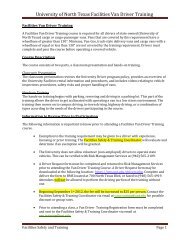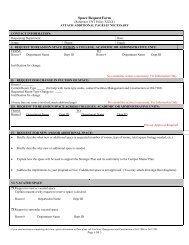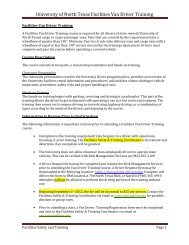FEDERAL SPACE SURVEY DEFINITION SHEET F ... - Facilities
FEDERAL SPACE SURVEY DEFINITION SHEET F ... - Facilities
FEDERAL SPACE SURVEY DEFINITION SHEET F ... - Facilities
Create successful ePaper yourself
Turn your PDF publications into a flip-book with our unique Google optimized e-Paper software.
<strong>FEDERAL</strong> <strong>SPACE</strong> <strong>SURVEY</strong> <strong>DEFINITION</strong> <strong>SHEET</strong><br />
The Space Survey requires that functional use for each room be entered as a percentage. Percentage use<br />
should be entered according to the most reasonable whole number (e.g. Instruction 62%, Organized Research<br />
38%). The total percentages for each room must sum to 100%. The functional percentages should reflect use<br />
for the fiscal year. It is understood that the dynamic nature of space may make it difficult to define use for the<br />
previous fiscal year. If you do not recall the usage, indicate usage as of the day you are completing the form<br />
and note this in the Comments section.<br />
Please note that the definitions below are specific to federal regulations and need to be followed closely in order<br />
for the University to be in compliance. More specific definitions and examples are attached for Instruction &<br />
Departmental Research, Organized Research, Department Administration, and Other Sponsored Activities for<br />
further reference.<br />
F u n c t i o n a l U s e s o f S p a c e<br />
Name Code Definitions<br />
Identify all<br />
Account<br />
Number(s)<br />
associated<br />
with space<br />
Instruction<br />
INST<br />
Space used for teaching and sponsored training activities (other than training<br />
regarding research techniques) including course preparation, classroom instruction,<br />
study areas for students, academic advising of students by faculty, and any other<br />
activities that involve credit or non-credit.<br />
NO<br />
Departmental<br />
Research<br />
DR<br />
Space used for general research that is not separately budgeted and accounted for.<br />
This includes preliminary research and individual research efforts that do not receive<br />
external or specific internal funding. An example of such programs is seed or start up<br />
funds for a new faculty member. Space coded as Departmental Research does not<br />
need to be supported with an account or grant number.<br />
NO<br />
Organized<br />
Research<br />
OR<br />
Space used for separately budgeted and accounted for research. This includes<br />
activities involving the training of individuals in research techniques (commonly called<br />
research training) where such activities utilize the same facilities as other research<br />
activities.<br />
YES<br />
<br />
University Research. Space used for separately budgeted and accounted for<br />
research supported by internal application of university funds (endowments, gifts,<br />
general funds and/or state appropriations.<br />
Sponsored Research. Space used to conduct research that is separately<br />
budgeted and accounted for and is supported by external source (e.g. federal<br />
Government, state or local Government, corporate, other private).<br />
Space indicated as Organized Research must be supported by identifying all<br />
funding (grant/account numbers) in the column(s) provided on the survey form.<br />
IF THE <strong>SPACE</strong> SUPPORTS DEPARTMENTAL RESEARCH THAT IS NOT<br />
SEPARATELY BUDGETED AND ACCOUNTED FOR, INDICATE THIS <strong>SPACE</strong> AS<br />
DEPARTMENTAL RESEARCH, NOT ORGANIZED RESEARCH.<br />
Department<br />
Administration<br />
DA<br />
Space used by department heads, deans, faculty or clerical staff for administrative<br />
purposes. This includes common use space that is utilized by the entire department<br />
that may include copy rooms, conference rooms, break rooms, and file rooms.<br />
NO<br />
Other<br />
Sponsored<br />
Activity<br />
OSA<br />
Space used for activity that is neither research nor instructional, however funded by<br />
external source (grant, contract, or cooperative agreement). Examples of such<br />
programs and projects are health service projects, drug studies (human subjects) and<br />
community service programs.<br />
YES<br />
Other<br />
Institutional<br />
Activities<br />
OIA<br />
If space cannot be classified into any other categories, this category should be used.<br />
Examples are animal care facilities (cage/cage washings), electronic repair shops,<br />
machine shops, and lab supply rooms. Consider the previous functions prior to<br />
selecting this category.<br />
NO<br />
VACANT VAC Space that is not being used now and has been vacant for more than six months of the<br />
fiscal year.<br />
NO
Space Function Definitions and Examples<br />
INSTRUCTION & TRAINING (INST)<br />
Activities providing teaching including training<br />
funded externally and instruction offered for credit<br />
and noncredit.<br />
Includes:<br />
classrooms<br />
classroom laboratories<br />
instructional computer laboratories<br />
instructional service rooms<br />
faculty and teaching assistant offices used only<br />
for instructional activities<br />
Excludes:<br />
department chair's office and support space<br />
Institutional libraries<br />
Training regarding research techniques (code as<br />
Organized Research)<br />
DEPARTMENTAL RESEARCH (DR)<br />
Research activities financed by the general<br />
operating funds and/or other funds such as gifts or<br />
endowments which are not separately budgeted<br />
and accounted for under an internal application of<br />
institutional funds that are not organized or planned.<br />
These funds are discretionary in nature and no<br />
financial reporting process is required.<br />
ORGANIZED RESEARCH (OR)<br />
The systematic study directed toward fuller<br />
scientific knowledge or understanding of the subject<br />
being studied in order to produce outcomes that<br />
contribute to new knowledge. In contrast to<br />
Department Research, Organized Research is<br />
conducted in an organized and planned fashion<br />
where there is a defined work statement, a specific<br />
commitment regarding deliverables and the level of<br />
personnel effort, specifically budgeted and<br />
accounted for (i.e., a line item budget detailing<br />
expenditures by activity and project period), and a<br />
formal report or response that summarized results<br />
of conclusions. Funding may be either from<br />
institutional funds (gifts, endowments, income,<br />
interest income, technology licensing income, or<br />
general operating budgets) or from external<br />
sponsors such as federal, state, corporations, and<br />
foundations.<br />
Includes:<br />
space used for research grants and contracts<br />
funded by federal or state Governments,<br />
corporations, and foundations<br />
space used to administer research grants and to<br />
prepare progress reports for current awards<br />
space occupied by faculty contributing effort<br />
(cost sharing) to sponsored research projects<br />
faculty and research assistant offices used for<br />
organized research activities<br />
space used for training of individuals in research<br />
techniques, commonly called research training,<br />
where such activities use the same facilities as<br />
other research activities<br />
ORGANIZED RESEARCH (Continued)<br />
Includes<br />
Departmental space used to house and support<br />
animals used in research that is not part of the<br />
Animal Care <strong>Facilities</strong> Organization.<br />
Animal Care Facility space used in conducting<br />
research by investigators apart from housing<br />
animal cages, cage washings and feeding.<br />
Excludes:<br />
Departmental Research<br />
Drug studies<br />
DEPARTMENT ADMINISTRATION /ACADEMIC<br />
SUPPORT<br />
This use of space includes activities providing<br />
administrative & clerical support and management<br />
direction for instruction & departmental research,<br />
organized research programs and/or other<br />
institutional activities. The use of this space is<br />
specific to provost/chancellor, college, or academic<br />
departments/centers.<br />
Includes:<br />
dean, department head and faculty offices and<br />
supporting service rooms<br />
clerical & administrative offices<br />
departmental libraries not part of the University<br />
Library system<br />
<br />
<br />
departmental conference rooms<br />
academic counseling and advising for faculty<br />
and staff<br />
departmental academic counseling and<br />
advising<br />
Excludes:<br />
space not used for administrative or clerical<br />
functions such as conducting instruction &<br />
departmental research, organized research, or<br />
other sponsored activities.<br />
clerical and administrative activities which<br />
benefit the entire University and/or a specific<br />
campus such as the Controller’s function, and<br />
other General &<br />
Administrative (Institutional Support) activities.<br />
OTHER SPONSORED ACTIVITIES<br />
Programs and projects sponsored by federal and<br />
non-federal agencies and organizations that are<br />
administered through the University’s Sponsored<br />
Projects Administration Office which involve<br />
activities other than instruction and organized<br />
research.<br />
Includes:<br />
sponsored non-credit community education<br />
sponsored community service programs<br />
sponsored health service projects<br />
sponsored clinical drug studies<br />
Continued in next column………









